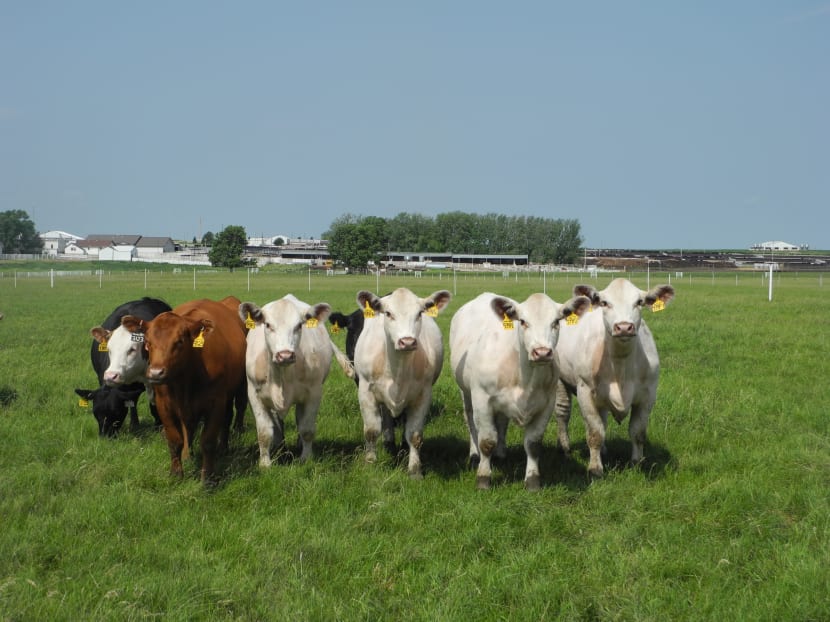The Dolly legacy: Are you eating cloned meat?
PARIS — Two decades after Scotland’s Dolly the sheep became the first cloned mammal, consumers may well wonder whether they are drinking milk or eating meat from cookie-cutter cows or their offspring.

This file photo taken on June 16, 2014 shows four white heifers, "genetic twin sisters" produced using cloning technology, from a very elite Shorthorn cow in the US, at the headquarter of Trans Ova Genetics in Sioux Center, Iowa. Photo: AFP
PARIS — Two decades after Scotland’s Dolly the sheep became the first cloned mammal, consumers may well wonder whether they are drinking milk or eating meat from cookie-cutter cows or their offspring.
The simple answer: “Probably”.
The fact is, there is no way to know for sure, say the experts, even in Europe, which has come closer to banning livestock cloning than anywhere else in the world.
With the possible exception of the ram sacrificed by Abraham in the Bible, Dolly must be the world’s most famous sheep.
The ewe’s birth in an Edinburgh laboratory on July 5, 1996 was front-page news, provoking hype and hand-wringing in equal parts.
For the most part, cloning turned out to be a dead end.
But there is one sector in which Dolly’s legacy is alive and well: The duplication of prize breeding animals.
How aggressively the private sector has developed this niche market has depended in large part on national or regional regulations, with key differences between the United States, China and the European Union.
US: FDA APPROVED
“The most dramatic impact of the cloning of Dolly has been on animal cloning in the United States,” said bioethics and cloning expert Aaron Levine at Georgia Tech.
In 2008, the US Food and Drug Administration concluded that “food from cattle, swine and goat clones is as safe to eat as food from any other cattle, swine or goat”.
Not even scientists can distinguish a healthy clone from a conventionally bred animal, the regulatory agency said.
There are no requirements to label meat or milk from a cloned animal or its offspring, whether sold domestically or abroad.
For industry, the aim was never to set up assembly-line production — cloning is difficult and expensive at more than €10,000 euros (S$15,000) a pop, and the success rate low, with few clones surviving to birth.
So the focus, instead, is on copying genetically outstanding specimens so they may naturally sire exceptional progeny.
“It’s fairly widespread in US to use cloning to produce breeding stock,” said Dr Levine. “Cloned animals are not intended to enter the food supply directly.”
“I suspect some may have,” he added.
Among the leaders in commercial livestock cloning in the US are Cyagra, based in Elizabethtown, Pennsylvania, and ViaGen, in Austin, Texas.
At least one company, ViaGen, also provides services for copying cherished cats and dogs.
CHINA, THE NEW FRONTIER
US companies typically produce hundreds or a few thousand clones per year.
The Boyalife Group’s cloning new factory near the northern coastal city of Tianjin in China, however, is aiming for an annual output of 100,000 cows this year, scaling up to a million by 2020.
Also in the pipeline are thoroughbred racehorses, pets and police dogs specialised in searching and sniffing.
Boyalife has said it is working with South Korean partner Sooam and the Chinese Academy of Sciences to improve primate cloning technology, to create better test animals for human disease research.
And in December, Boyalife’s lead scientist and chief executive Xu Xiaochun, said he would not shy away from cloning humans if regulations allowed it.
EUROPE COLD ON CLONING
Faced with strong public opinion against cloning of any kind, the European Union does not allow the practice in animal husbandry.
But officials acknowledge that meat or milk derived from cows with a cloned ancestor may very well have made its way onto the market, whether directly imported, obtained from a live imported animal, or one bred domestically from genetic material brought into the EU.
“Without knowing it, Europeans are probably eating meat from the descendants of clones that cannot be traced,” said European Office of Consumer Associations spokeswoman Pauline Constant, based in Brussels.
Officials say they are not concerned about any impact on human health.
In September, the European Parliament called by a large majority not only for a ban on cloned animals, but also on products derived from them.
The final decision rests with the European Commission, which has taken a less hard-line position.
Argentina, Brazil, Canada, and Australia are among the other countries which clone livestock. AFP






